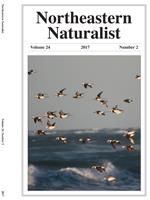Lasiurus borealis (Eastern Red Bat), long considered a common species, is now experiencing population declines. Most studies of their roosting habits have reported that the species uses mature canopy trees. We radio-tracked 2 adult male Eastern Red Bats to their roost trees in the Blue Ridge Mountains of Virginia in June of 2012. Both bats roosted in a different tree each day, but spent 3–5 days roosting in groups of nearby trees before making larger movements out of the study area. Characteristics of roost trees differed markedly between bats. One bat roosted in Castanea dentata (American Chestnut) and Quercus rubra (Red Oak) saplings in early-successional habitat; the other roosted in mature Quercus spp. (oaks) in closed-canopy forest. Most roost trees and nearby trees were shorter and smaller diameter than those reported in previous studies. Our results suggest Eastern Red Bats have relatively broad roosting habits that include use of both early- and late-successional habitat.
How to translate text using browser tools
1 June 2017
Roosting Habits of Two Lasiurus borealis (Eastern Red Bat) in the Blue Ridge Mountains of Virginia
Zackary A. Hann,
Micah J. Hosler,
Paul R. Moosman
ACCESS THE FULL ARTICLE

Northeastern Naturalist
Vol. 24 • No. 2
June 2017
Vol. 24 • No. 2
June 2017




